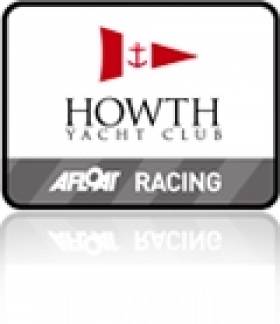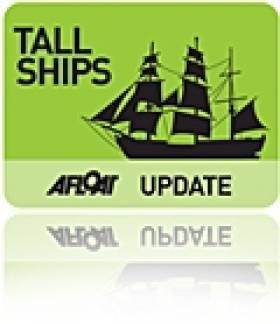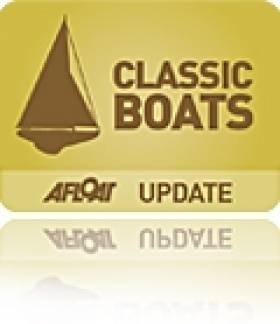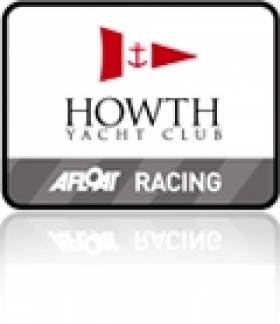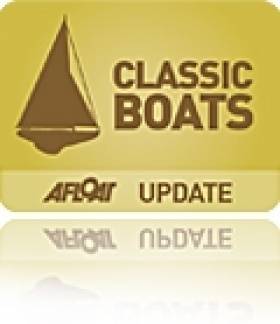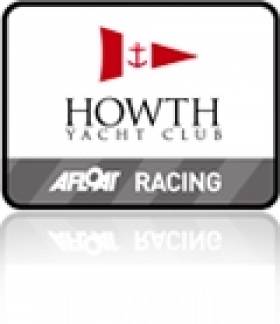Displaying items by tag: Howth 17
Howth Yacht Club Sailing Vid Features Seventeens & Squibs
#Jonathan Wormald's sailing video at Howth brings back yesterday's summer sun shine with beautiful aerial views of the Howth 17s and Squibs sailing in Howth Sound.
Howth's Maritime & Sailing History is Brought Centre Stage
#hyc – A new billboard on Howth Yacht Club's prominent gable wall has re-kindled local and general interest in the Fingal port's place in Irish and international sailing and maritime history. And it has led to an upsurge of warm local pride around Howth Harbour. After a summer visiting other ports, W M Nixon returns home and tells how it all came about, and of the re-vitalised seaborn sport which has resulted from this imaginative initiative.
The world's most historically interesting and best-preserved one design keelboat class is hidden in plain sight just 14 kilometres from the heart of Dublin. And at the entrance to the harbour where these very significant boats have their secret summer existence, there stands the most perfect little classic lighthouse you ever saw. It too is hidden in full view.
Or at least, it all seems virtually invisible for many of the folk who live in Howth, who have simply become so accustomed to the presence of the 1817-built lighthouse and the 1898-founded Howth Seventeen Class that they scarcely appear to notice them any more. They seem to take them for granted, as is the case many of the other special features of what is a remarkably successful fishing and sailing port.
Well, maybe they do take a little bit of notice. Certainly if some environment-altering project gets under way which doesn't meet with quiet general approval, you'd be surprised by the level of opposition which can be aroused, and with effect too. But it's part of Howth's reserved way of doing and seeing things not to make a song and dance about local features of importance and attraction when they are as they should be. For it is a fact that, well within living memory, Howth most certainly didn't exude prosperity. So the ingrained pessimism of a fishing port means that when things are going well and the place is functioning as it should, you just stay quiet and don't make a song and dance about the good times rolling.
Nevertheless, now and again when someone with experience of the outside world, and the standing to have opinions which matter, says that Howth is very special and it's time somebody said so, we're quietly rather pleased. And when it's done in in a way which has the style and effect of the new Mercedes-Benz billboard on the prominent gable wall of Howth Yacht Club, we're very pleased indeed.
This billboard encapsulates much that it is significant in the history of Howth Harbour, and it gets the spirit of the place. It shows four boats of the Howth Seventeen class (the "17" refers to their waterline length) gliding in close formation under their full jackyard tops'l rig into the harbour past the gem of a lighthouse in a photo which is so pin sharp that you can easily read the date plate of 1817 on the lighthouse.

The Howth Seventeens which made it to stardom are (left to right) Hera (Michael Duffy0, Oona (Peter Courtney), Isobel (Brian & Conor Turvey) and Aura (Ian Malcolm) Photo of David Branigan photo by W M Nixon
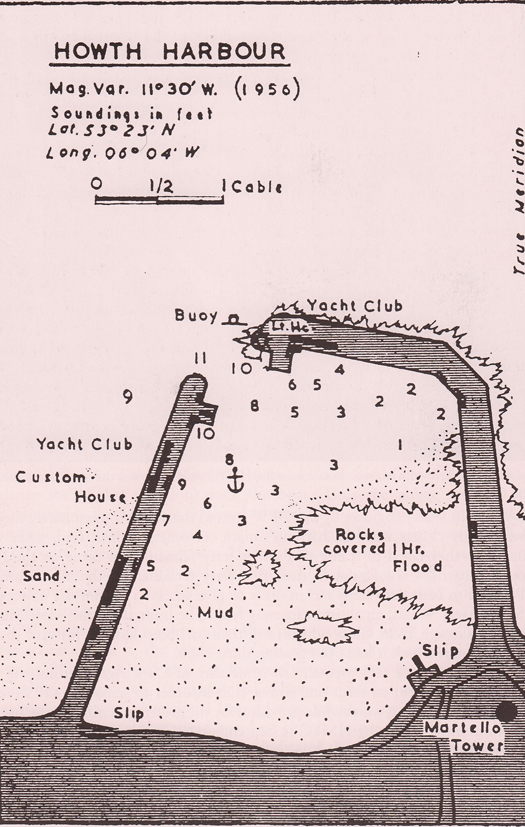
Howth was a distinctly disadvantaged port until relatively recently. Used as the main Dublin ferry port only between 1817 and 1826 (when Dun Laoghaire took over), it only became a "fishing station" around the 1840s-1850s. Then when the herring were fished out by the 1890s, some recreational boating space became available. But even by the late 1950s, as seen here, it was still a very limited harbour.
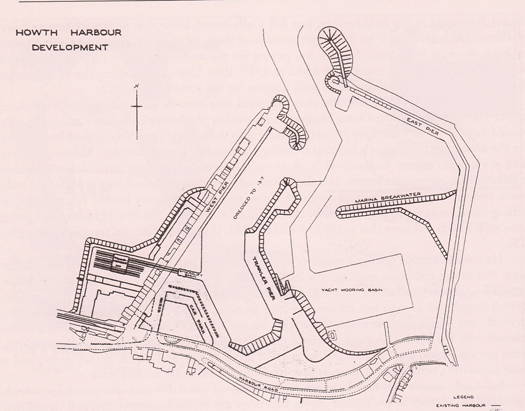
This outline plans for a major Howth redevelopment became available in the late 1970s. In those days, the very idea of a marina was anathema to some interests. So although a new breakwater is indicated as the "Marina Breakwater", the actual space in which Howth YC were to be obliged to install a marina at their own expense was only referred to as a "Yacht Mooring Basin".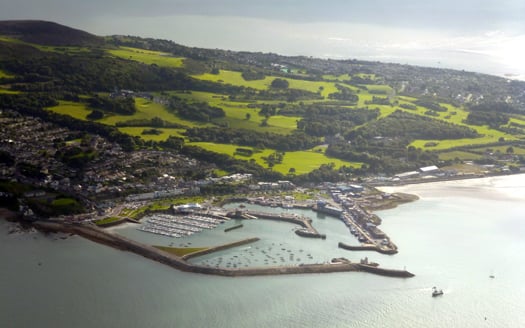
Howth Harbour as it is today, looking southwest across the peninsula with the waters of Dublin Bay at Sutton at top of photo. With clearcut boundaries between the different harbour uses, it has become a harmonious place. The presence of an active fishing port has led to a proliferation of good seafood restaurants. And the preservation of swinging moorings in the northeast corner of the harbour (foreground) has enabled the historic Howth 17s to survive and prosper. Photo: W M Nixon
The Howth Seventeens are part of Irish and international sailing lore. They still sail to the original design by Herbert Boyd of Howth House as signed off in October 1897, and they still race as keenly as they first did on May 4th 1898. More keenly, in fact - they currently have something like sixty races a year, and new boats and new owners and crews have lately been joining the fleet.
As to how they have acquired this overnight fame after 116 years, it's down to Stephen O'Flaherty of Mercedes-Benz. He brought together the needs of Howth YC for a sponsor for their Autumn League in concert with the fact that his quality marque sought a happy match with something which allied classic and timeless style, and could withstand the prolonged exposure of being on a highly visible billboard for the three years of the contract.
Working in close consultation with former and present HYC Commodores Derek Bothwell and Brian Turvey, the idea developed of a big screen photo which would encapsulate key aspects of Howth's unique maritime features in a clear and eloquent combination. Stephen O'Flaherty is owner of the achingly handsome Spirit 54 Soufriere, so he has an eye for a good-looking boat. And as a relative newcomer to being a Howth peninsula resident, he still sees it all afresh.
He pointed out that the little lighthouse at the end of the East Pier is still beautifully maintained, though it is now redundant as the working lighthouse is further north on the breakwater extension added in the early 1980s. Indeed, it is still even inhabited, and for many folk from elsewhere, that plucky little historic lighthouse symbolizes the spirit of Howth. It looks just as a lighthouse should, and it provides a perfect background for a sailing scene featuring the Howth 17s.
So all that was needed was a suitable day to get ace marine photographer David Branigan of Dun Laoghaire (who showed at last year's J/24 Worlds in Howth that he has a talent for drawing the locals' attention to the more picturesque aspects of their port and peninsula), line up half a dozen well-presented Howth Seventeens complete unto jackyard tops'ls, and get them in a harmonious arrangement with the lighthouse in the background and the flanks of the steep island of Ireland's Eye beyond, and lo and behold you have your magic picture, just like that.
Anyone who has ever tried to take a photo of just one boat sailing will realize what an extraordinary challenge this was, as even with one boat you're relying on the presence of a breeze, you're hoping for sunshine, and you're praying that when the best moment arrives, nobody will be standing up on deck or in the cockpit, or looking at the camera, thereby ruining the balance of the photo. And that's just with one boat.
Worse still, it all had to be brought together at very short notice. But the first day suggested for a photo shoot – Thursday August 28th and already under pressure with just two weeks and a couple of days to go to the start of the Autumn League – was a complete no-go with adverse conditions. Time was running out. It had to be Monday September 1st.
They had neither decent breeze nor sunshine on the day, and getting the Howth Seventeens to sail in concert is about as easy as herding cats. As for the wind, it was only fitful from the east, while to the inexperienced eye, the light seemed very flat, and no sunshine.
On top of that, team head Joanna Kavanagh of MSL had only been available on the Thursday – by Monday she was on another photo shoot in Portugal. But far from letting this get them down, the location team rose to the challenge. And the Howth Seventeen sailors gave of their best for a whole day. Show me a Howth Seventeen sailor, and I'll show you a ham......
In the cruel ways of Tinseltown, of the six Howth Seventeens which gave of their very best for that long and often frustrating day's shooting, two ended up on the cutting-room floor - Roddy Cooper's Leila and the Nick Massey syndicate's Deilginis. The final masterful Branigan photo shows Ian Malcolm's Aura (no 7) ahead of Peter Courtney's Oona (no 17), Conor and Brian Turvey's Isobel (no 19) and Michael Duffy's Hera (no 9).
As a sailing photo, it mightn't garner enough excitement to make it into a yachting magazine. But as a billboard designed to tell a story in a specific location, it tells ten thousand words, and tells them very well too. And as clearly as possible – Jason Hurley of Jason Hurley Designs, who was involved in the shoot, also cleaned up the raw photo afterwards to enhance it and take out stains from sails, scrapes from topsides, and weed from waterlines. When it went up just three days before the Autumn League was due to start on Saturday September 13th, it was to be greeted with a shared wave of enthusiasm of a kind which is rare enough in a quirky little community like Howth.
Needless to say, there were soon the usual quips to be heard. The Howth Seventeens survive through turning the laws of physics on their heads. Thus while energy creates friction for other folk, among Seventeen-footer persons it's friction which creates energy. There's nothing like a barbed remark or two to sharpen enthusiasm for the next race. So for those who have said that it takes a posed billboard photo to ensure that Ian Malcolm with Aura will be at the head of the fleet, let me say that in addition to winning races now and again, nobody else in the class has done as much to tell the world that the Howth Seventeens are alive and well and sailing more keenly than ever, and here's a selection of just some of the things that Aura has done in the last sixteen years:
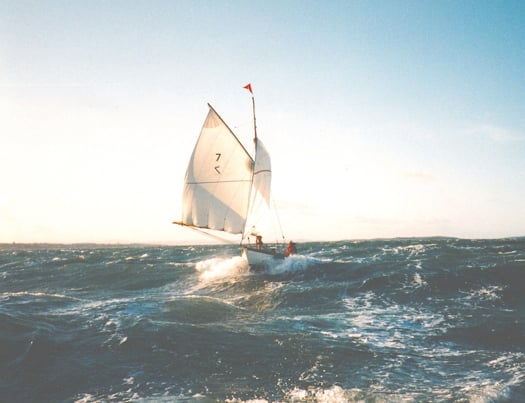
Aura goes offshore. In 1998, the Howth 17s celebrated the Centenary of their inaugural voyage from builder John Hilditch of Carrickfergus 95 miles non-stop back to Howth. Aura is seen here starting to get offshore off the County Down coast as a bright but very cold evening draws in on April 15th 1998. Photo: Damian Cronin
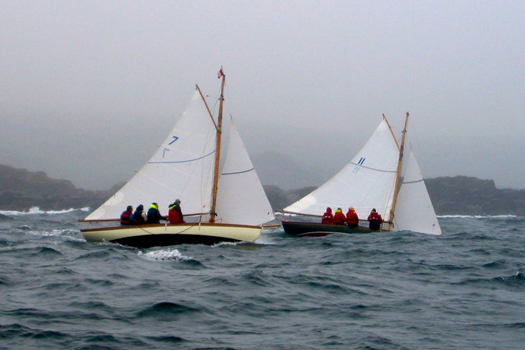 The Howth 17s make the scene at the Glandore Classics 2003 with a foggy race from Castlehaven to Glandore. Here, Aura is chasing Deilginis close inshore. The winner was the first boat to have a crewman downing a pint in Casey's bar in Glandore. Photo: W M Nixon
The Howth 17s make the scene at the Glandore Classics 2003 with a foggy race from Castlehaven to Glandore. Here, Aura is chasing Deilginis close inshore. The winner was the first boat to have a crewman downing a pint in Casey's bar in Glandore. Photo: W M Nixon

In 2008, Aura was the only Howth 17 to take part in the Waterways Ireland Classic Boat Regatta at Dromineer on Lough Derg. She is seen here sharing the lake with an International 12, Water Wags, Shannon One Designs and a Folkboat together with the 1873-built committee boat Phoenix (John & Sandra Lefroy). It was the first time a jackyard tops'l had been seen on Lough Derg since before the Great War of 1914-18, as the post-war fleet there were either gunter or Bermuda rigged. Photo: Gerardine Wisdom

Aura and Deilginis off the Royal Yacht Squadron Castle at Cowes in July 2013 during the Classic One Designs Regatta. It is thought to be the first time the Howth 17s were in the Solent. Photo: Mel Massey
As to the Howth Autumn league, it started 35 years ago in a low key sort of way, when the boats of the newly-formed Squib Class realized they'd been at full first season fleet numbers for only a few weeks, yet if they followed the local wooden-boat traditions, they'd soon be laying up. But the Squib is a minimal maintenance little 19ft keelboat, most of the boats were new in any case, and the Lasers had been having their annual winter series in Howth since October 1974. So the Squibs decided to tag themselves on to the Laser race officer team, and continue their sailing until early December, and thus was the Howth Autumn League born, though it didn't become a fully-fledged all-keelboat-classes business until the marina opened in 1982.
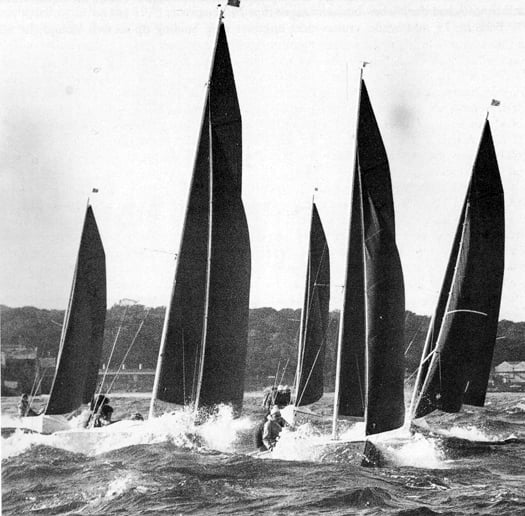 When it all started. The newly-established Squib Class inaugurated the Howth Autumn League in 1979, and this was the first race of that series. Photo: Jamie Blandford
When it all started. The newly-established Squib Class inaugurated the Howth Autumn League in 1979, and this was the first race of that series. Photo: Jamie Blandford
Underlying all this, the Howth Winter Lasers will be celebrating their 40th Anniversary. And it also means that HYC have had a continuous sailing programme since their Opening Day in April 1974. But last weekend the first race of the Mercedes-Benz Autumn League 2014 was enough to be going on with, sailed to mark the new sponsorship and the 35th anniversary of the inaugural Autumn League. And as I was one of those mad keen little Squib skippers 35 years ago, it was an ideal opportunity to take up an invitation to race on Soufriere and mark it all with a bit of style.
She has been having a good year on the race courses. Stephen O'Flaherty has teamed up with David Cagney to bring that wayward sailing genius into his regular crew, and while you wouldn't dream of calling them the Odd Couple, the phrase springs irresistibly to mind. They have raised Soufriere's racing to a new level, with an excellent win in the long inshore race at the Panerai Classics at Cowes in July, and then last month they found a new level of joint success with an extremely good debut in Two-Handed racing in the Aqua Double-Hander at Howth, leading a fleet of 34 boats on the water and on corrected time for much of the race round Lambay and the Kish and back to Howth Harbour, only slipping to a close second overall through being becalmed for a couple of minutes just yards short of the finish line.
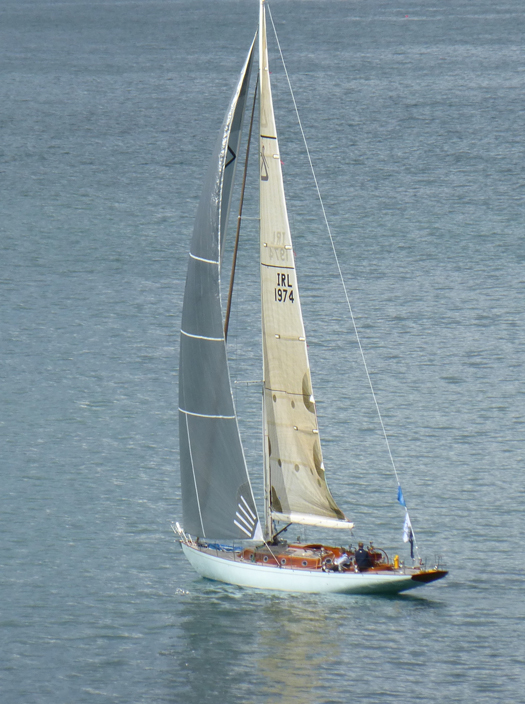 Soufriere approaching the finish of the Aqua Double-Hander at Howth in August, when she would have won overall on both handicaps had she not been becalmed for four minutes within yards of the line. That race-winning headsail may look gossamer light, but on a 54-footer it weighs around 40 kilos, and it's quite a haul for a two man crew to get it aloft. Photo: W M Nixon
Soufriere approaching the finish of the Aqua Double-Hander at Howth in August, when she would have won overall on both handicaps had she not been becalmed for four minutes within yards of the line. That race-winning headsail may look gossamer light, but on a 54-footer it weighs around 40 kilos, and it's quite a haul for a two man crew to get it aloft. Photo: W M Nixon

A penny for your thoughts....David Cagney and Stephen O'Flaherty pondering the options for Soufriere when their just isn't enough wind to get the big lady moving properly. Photo: W M Nixon
Many folk would think it absurd to race a "new classic" like Soufriere against the likes of our opposition last Saturday, as it included Nobby Reilly and Alan Chambers' Mills 36 Crazy Horse, and the Kelly team's J/109 Storm which is always there or thereabouts in ICRA Racing, and has been ICRA Boat of the Year in her time. But Soufriere has a modern underwater profile of vertical bulb keel and spade rudder, and despite her very attractive wood construction in edge-glued strip planking, her all-up weight is only about nine tons.
Nevertheless, she does have to cart about these elegant long ends, which are only an asset for extra speed when the wind is above a certain strength. To add to the challenge, the ideal minimum wind varies, dependent on which point of sailing you're on. Beating, she seems to come to life in as little as 6 knots real wind speed. Reaching, you need about 8 knots. But downwind, she's sticky until it's getting near 10 knots, and preferably more.
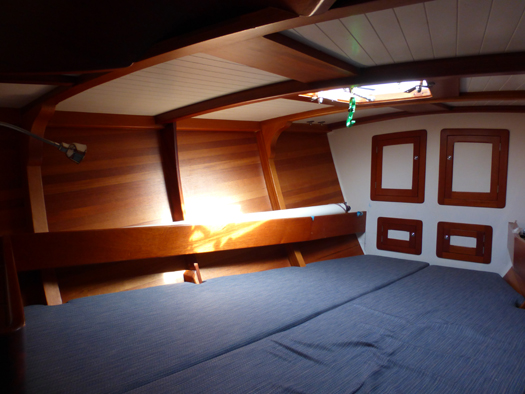
The forward cabin shows the Spirit style. With the wooden hull unlined, the noise of the water going past is pleasantly distinctive. Photo: W M Nixon
As to the impression on going on board, you have to think of Soufriere as they do with the Howth Seventeens, in terms of her waterline length. She certainly doesn't have anything like the accommodation of a standard modern 54 footer, and even her waterline length of 12m (39ft 8ins) suggests more room than there is, as her beam is only 3.3m (10ft 10ins). But within that, the accommodation is welcoming and elegant, and the boat gives out very pleasant vibes, as she is immaculately maintained by Tim Foley of Dun Laoghaire.
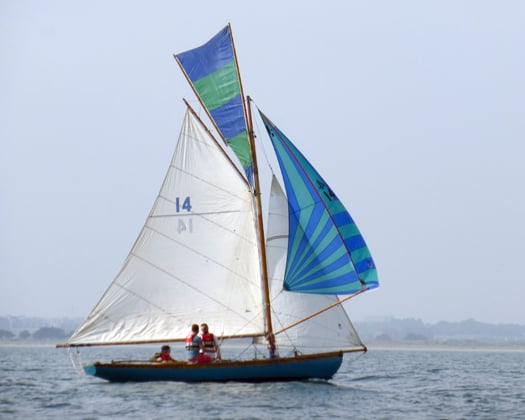
Back in harness. Aidan MacManus of the King Sitric Restaurant has re-joined the Howth 17s by buying the Howth 17 Gladys in partnership with Kieran jameson and others. He first bought Gladys in 1974, and is the first helmsman to have won a race in the Seventeens with 16 other boats astern. Photo: W M Nixon
Going out for the that first race of the re-vitalised Autumn League last Saturday, we motored quietly along past noted restaurateur Aidan MacManus in his Howth 17 Gladys, which he has re-bought in partnership with Kieran Jameson and others. Aidan first bought Gladys in 1974, and he is written permanently into the class's history as in 1988 he was the first skipper ever to win a Howth 17 race with 16 other boats behind, for in a class of such great age, it's seldom that any season will see all the boats afloat.
The wind was light easterly on a day which belied it was mid-September, shirt sleeves stuff and careful reading of summery conditions which were too light for Soufriere. But the team gave it their best shot, and when there was occasionally that essential little bite to the breeze, suddenly we were at the races.
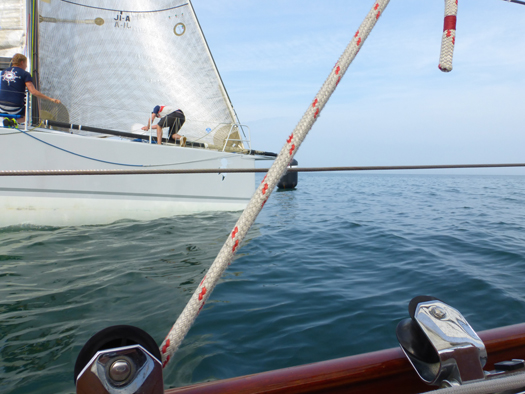
Reaching the weather mark neck-and-neck with Crazy Horse but miraculous to tell.......... Photo: W M Nixon
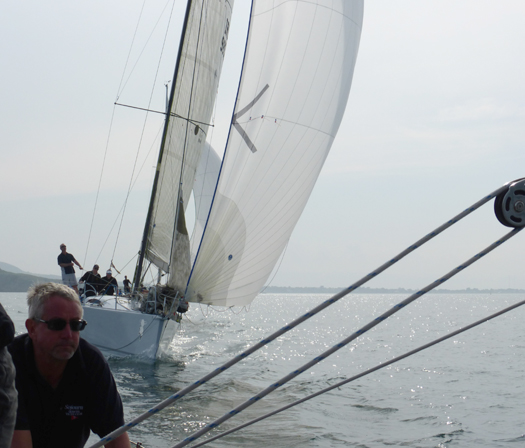
....on the reach Soufriere found her groove and the Horse was soon put astern......Photo: W M Nixon

.....and for as long as we were on the reach, we were lengthening away......Photo: W M Nixon

.....while the crew prepared for the run. Photo: W M Nixon
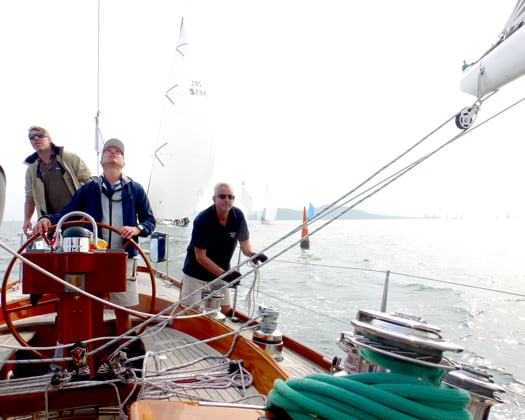
Deflation. We pass the mark at the end of the reach, knowing the run can only mean one thing.......Photo: W M Nixon
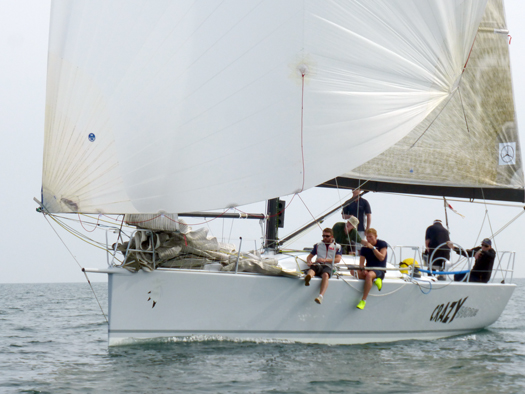
....and with her spinnaker pole deployed, Crazy Horse was soon rolling over us, so we gybed away into what proved to be the light wind side of the leg. Photo: W M Nixon
We rounded the first weather mark vying for the lead on the water with Crazy Horse, and then - mirabile dictu – Soufriere found her mojo and rolled over the Reilly-Chambers boat and led down the short reach to the next turn, but after that it was a wearing dead run with light patches everywhere. Crazy Horse was soon over us again, and as we don't carry a spinnaker pole, we were tacking sharply to lee down the left hand of the run where winds became lighter, while the Horse and Storm went to the right to find a better breeze, and both were ahead at the lee mark.
But then they clearly reckoned they'd used up all the breeze over to the northeast during their success on the run, so for the beat they went to the right where we'd been flat on the run. We meanwhile were left all on our own to do what we wanted, taking a big punt to the left, and it paid in spades. Getting back up to the weather mark, Storm was well astern and we were snapping at Crazy Horse's heels.

On the second long run, we managed to keep in contact with Crazy Horse.....Photo: W M Nixon

.....while Storm took the scenic route, seeking a private breeze in under the cliffs of Ireland's Eye. Photo: W M Nixon
The next run piled on the pain, but somehow we were hanging in with Crazy Horse, and Storm took a flyer right in under the cliffs of Ireland's Eye. With the wind fading, the Committee Boat had gone over towards Malahide to shorten the course at the lee mark, and a fine selection of the 97 boat fleet were running down together towards it from their various courses.
It made for a very civilised finish time instead of hanging around far into the evening, and we might have hoped for a third or even a second as the long lady which is Soufriere had been doing her very best. But then, just as we neared the finish, didn't the breeze pipe up for a crucial quarter of an hour. We finished at a crisp little speed, but down towards Ireland's Eye the two J/109s and the X332 Equinox were coming up towards the finish with bones in their teeth, and a reasonable chance of a third or even a second for us evaporated to fifth, suddenly three minutes down on the fourth-placed J/109 Dear Prudence (Patrick Cruise O'Brien), while the other J/109 Storm had finished at such speed she pipped Crazy Horse for the win.

At last a bite to the breeze, but we're just about to finish.......Photo: W M Nixon
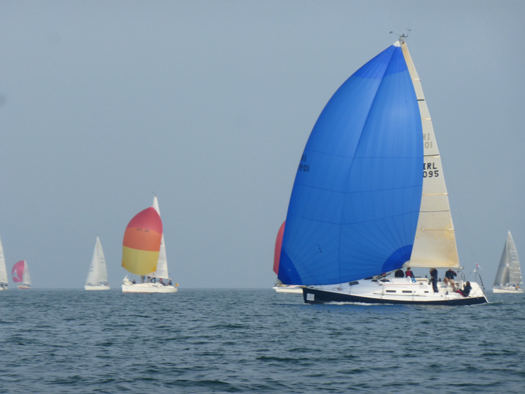
.....so the brief but temporary breeze at the finish brings up the tail-ender Dear Prudence with a bone in her teeth, and Soufriere is pushed back into fifth on CT. Photo: W M Nixon
But that's boat racing. It had been an interesting day in good company, and when she could, the lovely Soufriere rewarded us with competitive performance, at all times with the water tinkling past in that special way it does with a wooden hull. She was a joy to be aboard.
On the 35th Anniversary of the introduction of the Howth Autumn League, it was good to be heading back in the hazy evening sun into this regenerated port where modern facilities are right beside the traditional anchorage. There, the eternally re-born Howth 17s were striking their tops'ls after an afternoon's racing, just as they've always done for 116 years, while continuing with the banter which will go on for ever.
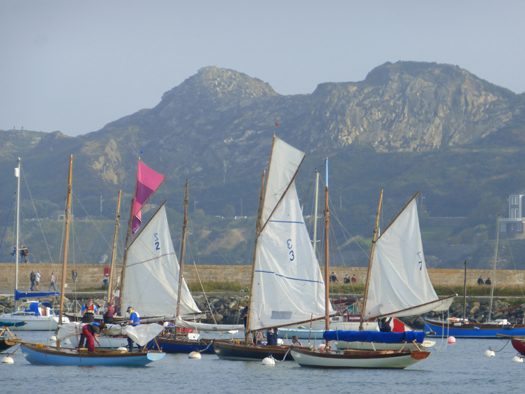
The Howth 17s striking their tops'ls after a Saturday afternoon race, as they have been doing for 116 years. Photo: W M Nixon

A very likeable boat, and remarkably rewarding to race against more modern types. Soufriere in her berth at Howth after the first race of the MSL Autumn League 2014 at Howth, showing the quality of the work Jimmy Foley of Dun Laoghaire puts into her maintenance. Photo: W M Nixon
Commodore's Yacht Wins Howth 17 Championships
#howth17 – The weekend's Howth 17 Footers Championships was won by Brian & Conor Turvey's 'Isobel'. Winning two of Saturday's four races and following a lengthy protest hearing between 'Deilginis' and 'Rita' (the latter then being disqualified from Race 2) afforded the Isobel team a victory by one point from Peter Courtney's 'Oona' with Ian Malcolm and crew of 'Aura' collecting their bronze medals for 3rd.
The event coverage included a first race aerial vid by Skypixels featuring the fleet (above).
Ian Sheridan's 'Erica' couldn't replicate their winning form from the previous evening, but were popular winners of the Handicap Trophy. Following praise for the Class Captain Mary Faherty and her running of the event, Commodore Brian Turvey thanked the race management team and their National Race Officer Scorie Walls for an excellent series, relaying particular thanks for the great work of the mark-laying teams following their swift action in the last race in managing a 60 degree wind direction shift.
Ireland's Oldest Wooden Boats Aren't Getting Any Younger
#woodenboats – On Midsummer's Day, W M Nixon looks back on the already busy and event-filled Irish season of 2014, and reflects on the extraordinary longevity of some boats, their remarkable variety, and the diverse characters who own them.
When I shipped aboard the former Bristol Channel Pilot cutter Madcap to sail the Old Gaffers Division in Howth Yacht Club's Lambay Race on June 7th, it wasn't the first time I'd been out and about on a boat built in the 1870s. But as most of my experiences on John and Sandra Lefroy's 1873-vintage iron-built classic 58ft Victorian steam yacht Phoenix on Lough Derg took place in the 1970s with the most recent jaunt being way back in 1982, sailing on the Madcap was indeed the first time afloat in a boat built 140 years ago.
It takes an effort to get your head around the most basic notion of such an age. You find yourself reflecting on the delights that still awaited the human race at the time, things that were still far into the remote future in the 20th Century. During the 1870s, industrialisation was still gaining traction, but the very idea of warfare on the industrial scale which was to be experienced in the Great War of 1914-18 was beyond most people's imagination, and way beyond anyone's experience. That said, there were more than enough other ways of experiencing an early death, with a range of particularly unpleasant illnesses which have been largely eliminated today.
Yet it was increasing industrialisation which created the circumstances that enabled both boats to be built. The Bristol Channel Pilot cutters evolved rapidly in the latter half of the 19th Century in order to provide pilots for the more numerous and increasingly large ships which were coming into ports such as Cardiff and Bristol. They reached their peak of performance around 1900, by which time they'd achieved a remarkable stage of development, being fast and able, yet comfortable at sea, and capable of being handled by a very small crew after the pilots had been delivered to incoming vessels. When their working days were over as they were replaced by motorised vessels, they proved ideal as seagoing cruising yachts.
There was nothing work-oriented about the pleasure yacht Phoenix when she was built to the designs of Andrew Horn in Waterford in 1873. Or maybe that's being a bit naïve. After all, she is down as having been built by and for the Malcolmsons of Waterford. They were a remarkable clan who brought many industries to Waterford in the 19th Century, and they created the miniature industrial town of Portlaw westward from the city, off the south bank of the Suir Estuary.
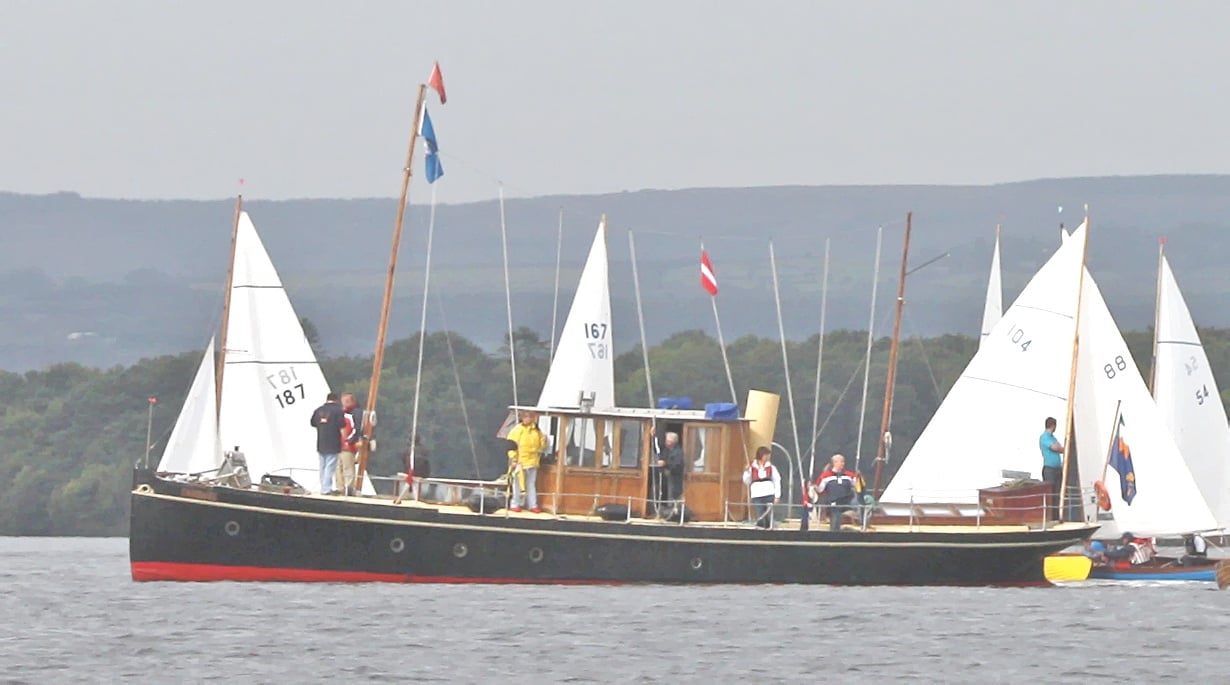
The 58ft Phoenix, iron-built in Waterford in 1873, performing Committee Boat duties at Dromineer for Lough Derg YC. Photo: Gerardine Wisdom
So in building the Phoenix themselves, so to speak, they were creating a subtle advertisement for Waterford expertise, with this new miniature of an ocean liner being constructed in the highly-regarded Lowmoor iron. And she's a powerful statement - this lovely old vessel has lasted much better than many of the Waterford enterprises which outshone her at the time of her building, so much so that if, in Waterford's current recessional woes, they sought something to symbolise what the city is capable of, they would do worse than put some resources the way of the Phoenix for her continuous maintenance.
Five years ago she made a very stylish appearance as the Committee Boat in a classics regatta at Dromineer, and that in turn produced an astonishing photo which included Ian Malcolm's 1898-built Howth 17 Aura. It was the first time a jackyard topsail had been seen on Lough Derg since before the Great War, and all that together with a raft of Shannon One Designs (which date from 1922 onwards) and a fleet of Dublin Bay Water Wags from 1902 onwards meant that the total age of the boat in the photo was pushing towards the 2,000 years mark.

Phoenix and the 1898 Howth 17 Aura (Ian Malcolm) at Dromineer with rafts of Shannon ODs and Water Wags. The combined age of the bots in the photo is well over a thousand years. Photo: Gerardine Wisdom
To be aboard Phoenix is to be transported right back to the 1870s, as she has a beam of only 10.5ft, which on a length of 58.5ft make for one very slim and potent hull. She has long since had her original steam engine replaced with a diesel, and back in 1982 when I was last afloat in her, it was October, and we were the Committee Boat for the annual IYA Helmsmans Championship, raced that year in Shannon One Designs with Dave Cummins of Sutton the winner, crewed by Gordon Maguire.
Being late season, the Phoenix's injectors needed a clean, but as the Race Officers were those perpetual schoolboys Jock Smith and Sam Dix of Malahide, they were delighted by the Phoenix's ability to emit a fine plume of smoke from her funnel at full speed, and after the championship was resolved they tore across the lively waters of Autumnal Lough Derg at full speed while – from another boat - I grabbed some photos which made Phoenix look like a destroyer in action at the Battle of Jutland. One of them subsequently appeared as the cover of Motor Boat & Yachting, and as I seem to have mislaid the colour slides, if anyone has a copy of that particular edition I'd much appreciate a scan of it.
Moving on from the 1873-built Phoenix in 1982 to the 1874-built Madcap in 2014 is quite some saga, but we'll edit it by sticking to events this year revolving around the developing annual Old Gaffer programme in the Irish Sea. Last year Dickie Gomes' 1912-built 36ft John B Kearney yawl Ainmara from Strangford Lough won the inaugural Leinster Trophy race in Dublin Bay which marked the OGA's Golden Jubilee, and she did it despite now being bermuda rigged. But as she was returning to her birthplace in Ringsend for the first time in 90 years, she was treated as an honorary gaffer.
Honour being the theme of things, this meant we were honour-bound to bring her south again to defend the Leinster in 2014, but this was given an added impetus by a plan to link up in Dun Laoghaire with Martin Birch's 1902-built Espanola out of Preston in Lancashire. From 1912 until 1940, the 47ft Espanola was a feature of the Royal Irish YC in Dun Laoghaire, owned by noted sailor Herbert Wright, who in 1929 became the founding Commodore of the Irish Cruising Club when he cruised Espanola with four other yachts to Glengarriff where the ICC was founded on July 13th 1929. The Espanola links, together with the fact that the RIYC is now in partnership with Wicklow Sailing Club in hosting the fleet for the biennial Round Ireland Race, made for a fortuitous combination, as Dickie Gomes of Ainmara was Mr Round Ireland between 1986 and 1993, when he held the open Round Ireland Record and also had been overall winner of the 1988 race.

Espanola as she was in 1929, when Commodore's yacht at the founding of the Irish Cruising Club
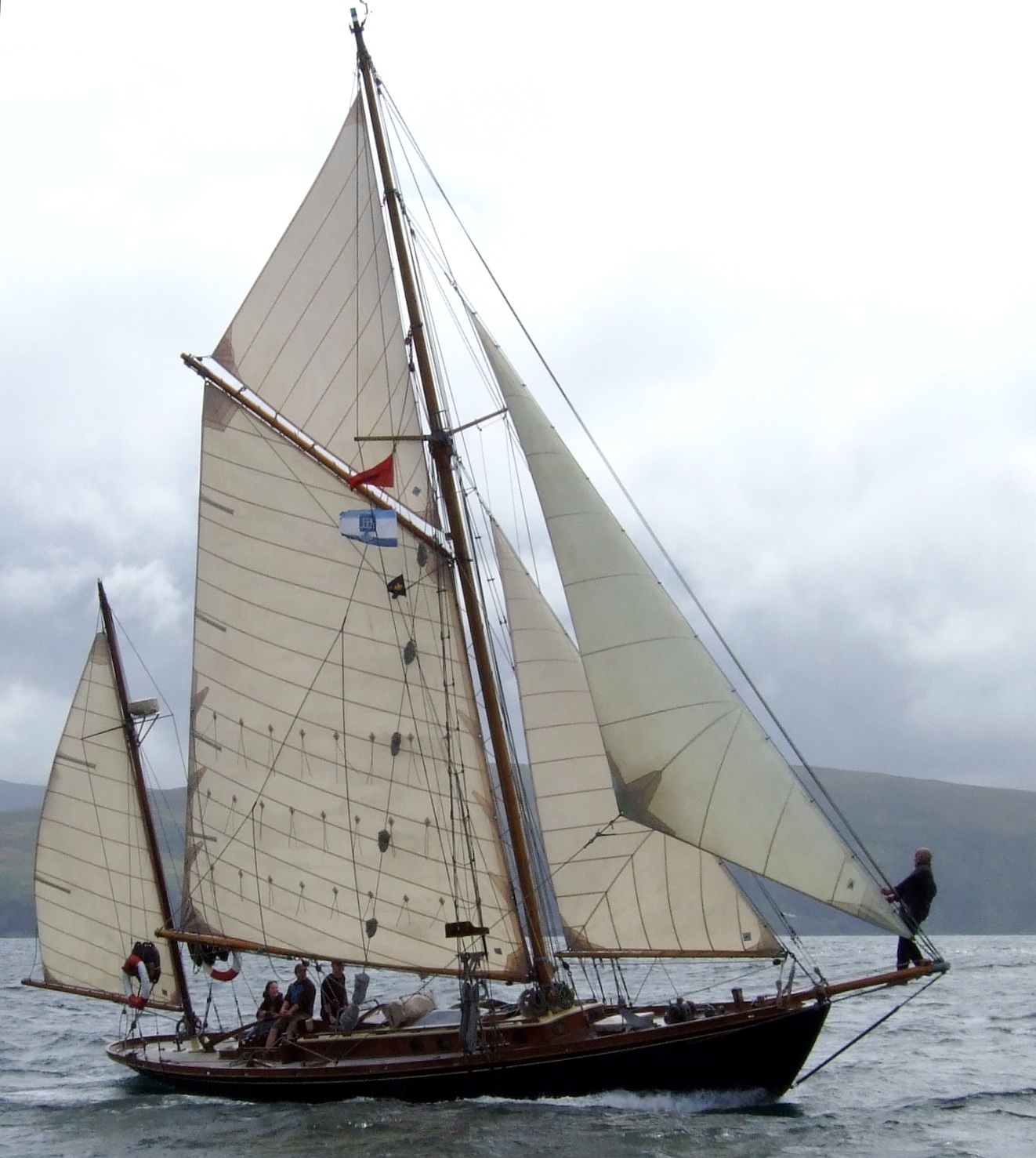
The 1902-built Espanola as she is today
Thus all the stars were in alignment for an historic and convivial meeting of the two old boats at the RIYC on the evening of Friday May 30th, the night before the Leinster Plate race was due to start just round the corner in Scotsmans Bay. But while stars may have been in alignment, ducks failed to get into a row, as Espanola with her exceptional draft of 7ft 6ins failed to get out of Preston over the shallow bar in the one tide which would have suited, on May 16th.
This situation is a useful illustration of the problems the old gaffer people face in keeping the show on the road with limited resources. Martin Birch, having been a lecturer in Lancaster University, had found Preston's little marina an ideal place to keep and maintain Espanola, and the marina in turn regarded the old girl as their pet boat. But Preston is longer a busy commercial port, so the channel has been left to is own devices, and with the huge tides of the Lancashire coast, getting Espanola to sea is quite a challenge as sometimes there's only one day in any month when it can be done.
So there we were, faced with the prospect of Hamlet without the Prince with just ten days to go to the historic gathering at the RIYC. But Jim Horan, affable Commodore of the Royal Irish YC, took it all in his stride and told us to bring Ainmara along anyway, it would be a good excuse for a Friday night party and he was keen to meet the skipper who had made the Round Ireland challenge very much his own 28 years ago.
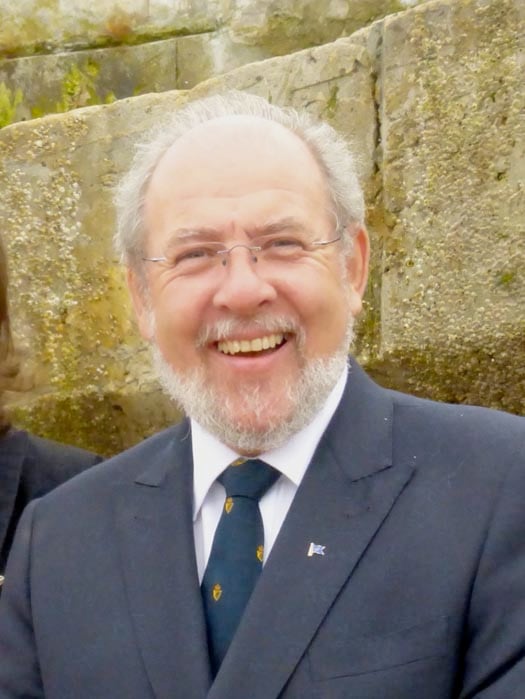
Jim Horan, Commodore of the RIYC, told us to come on and be welcome even though Espanola couldn't make it. Photo: W M Nixon
With the foul weather of mid-May, while Ainmara had got afloat from her winter quarters in a hayshed at the Gomes farm on the Ards peninsula in County Down, further fitting out was difficult in endless rain, and the skipper came down with a massive cold. But then the weather perked up, and he did too, so at lunchtime on Thursday My 29th we headed down Strangford Lough from the Down Cruising Club's former lightship headquarters at Ballydorn to catch the start of the ebb in Strangford Narrows at 1430 hrs.
Progress was good with a light to moderate nor'easter, but Ainmara and her crew (there were four of us – Brian Law, Ed Wheeler and I together with Dickie) have got to the stage where nights at sea are regarded to be the result of bad cruise planning. Yet if we were going to be comfortably in Dun Laoghaire for Friday evening, then only Port Oriel at Clogherhead made sense as an overnight. But Port Oriel, home to some of the best-maintained fishing boats on the coast, can become a very crowded place on a Thursday night.
However, a phone call to the uncrowned king of Clogherhead Aidan Sharkey – whom I'd first met back in the 1980s when our two boats were moored in Seal Hole at Lambay, where he was diving on the nearby 1854 wreck of the Tayleur - ensured there'd be a berth for us, and when we arrived in at sunset there was the man himself to direct us to a corner where we wouldn't inconvenience fishing boats, and moreover had access to a set of proper steps.
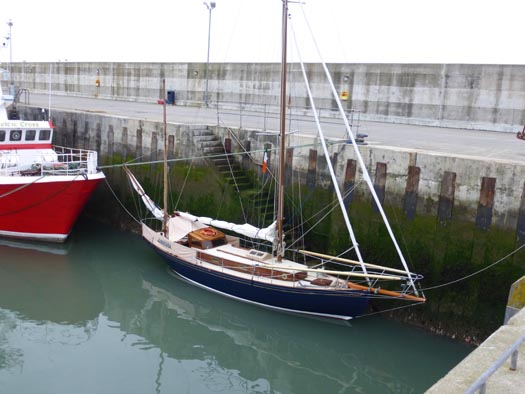
Port Oriel at Clogherhead provided Ainmara wih a handy overnight stop. There was more space available (below) as most of the 30-strong local fleet were away fishing the south coast. Photos: W M Nixon

Aidan's commitment to the maritime life is total. He's of an old Clogherhead fishing family, and he and his late brother Feargal were the backbone of the local beach-launched lifeboat crew. The banter was mighty on board Ainmara, leavened with tales of lifeboat experience which would curl your hair. The laughter through the companionway attracted others board, and soon Sean the razor clam man (all of his catches go straight to China) was in the hatchway with glass in hand, and when we asked where we might get a new deck scrub first thing in the morning as somehow the ship's own one had gone AWOL, Sean said not to worry, he'd throw one on board, and we could just leave it on the big fishing boat beside us as we left next day.
Ashore, I went up to Aidan's house in the village as he'd said he'd something to show me, which was an understatement. He was into the diving much earlier than most, thus when he got to wrecks which today are known to everyone, there were still intact bits of the cargo to be salvaged. Most east coast divers have fragments of chinaware, pottery and other artefacts from the Tayleur, but Sean had so many complete pieces, together with many other items of special antique value from other wrecks mostly in Donegal, that he would be well able to provide complete afternoon tea for the entire choir, all served on 1840s china. But it wasn't tea I got in the Sharkey household, it was Aidan's present of a large bag of fresh crab claws, and a selection of his own-cured salmon – smoked and gravid lax both – which sustained us through the next day's sail.
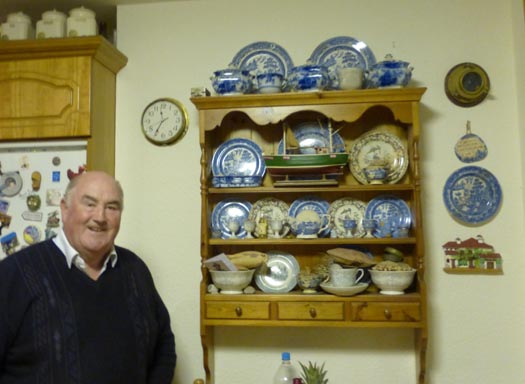
Aidan Sharkey of Clogherhead with some of his remarkable collection of salvaged chinaware. Photo: W M Nixon

The sort of sailing cruising folk dream of. Ainmara shaping up nicely to take the first of the fair tide through the islands at Skerries. Photo: W M Nixon
The morning brought the welcome gift of a decent little sunny east to nor'east breeze, and a lovely beam reach all the way down to Dublin Bay, with the south-going tide caught to perfection at the Skerries islands (and yes, I know it's superfluous to talk of the "Skerries islands", but that's what they're called to differentiate them from the Skerries off Holyhead).
Anyone who was involved in last weekend's ICRA Nationals at the Royal Irish YC will know how this premier club can lay on the welcome with effortless style. In the last weekend of May, Ainmara and her crew had the Royal Irish treatment all to themselves. Sailing Manager Mark McGibney ushered us to the prime berth right at the club where we found ourselves in a miniature maritime museum, with the Quarter Tonner Quest close astern (she was to become the ICRA National Champion a fortnight later), while just across the way was the S&S 36 Sarnia – back in 1966, the Sisk family set Irish sailing alight by bringing this very up-to-the-minute fin-and-skeg fibreglass boat back from builders Cantiere Benello in Italy, where they'd started series production on this ground-breaking Olin Stephens design before the same hull shape became better known as the Swan 36 built by Nautor in Finland.
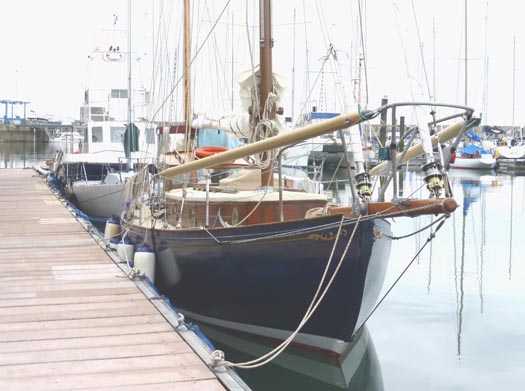
"Maritime museum" at the Royal Irish YC. Ainmara (built Ringsend 1912) with the 1987 Quarter Tonner Quest astern, and the 1966-built S&S 36 Sarnia across the way in her marina berth. Photo: W M Nixon
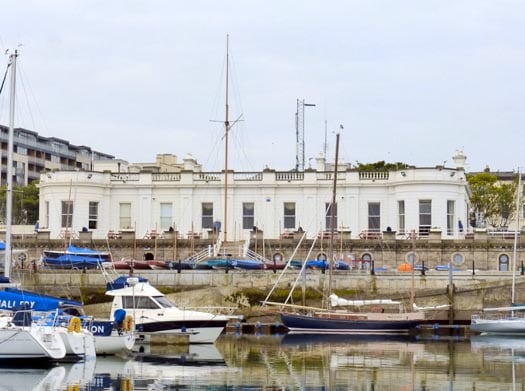
It has to be one of the best berths in the world. Ainmara at the RIYC – it's early morning, and the flags aren't yet hoisted. Photo: W M Nixon
The hospitality flowed seamlessly as the late afternoon graduated into evening and then velvet night. Ainmara is an extraordinarily effective calling card, and the stream of entertaining visitors brought laughter aboard before the Commodore moved us all up to the clubhouse and a fine supper and much chat with Michael O'Leary, one of the most visionary minds in Irish sailing, and his wife Kate and her people with tales of how she and longtime friend Clare Hogan are in the thick of things in the very healthy Water Wag class.
The RIYC took all this in its stride despite the fact that there was a big wedding going in the clubhouse at the same time, but it all went so smoothly that at one stage Ainmara's crew found themselves being invited to join in the wedding celebrations. However, we demurred because we were athletes in training for the Leinster Trophy next day, yet nevertheless certain key players in the wedding got themselves aboard Ainmara at a very late hour.
The plan for Saturday had been changed, but we were right up to speed with this as Denis Aylmer, the RIYC's key man in the OGA, had told us over a convivial pint that the likelihood of light winds had meant that Race Officer John Alvey had moved the scene of the action from Scotsmans Bay to a more compact race area close off the entrance to Dublin Port. It was all grist to our mill, as we could make an early morning departure and head up to Poolbeg Y & BC across a mirror-like bay, lining up the crew to salute the North Bank Lighthouse in the River Liffey, as it's something of a memorial to John B Kearney, whose day job was in the engineering department in Dublin Port and docks. With his original lighthouse, he pioneering a technique of screwing the piles into the seabed. You'd have thought an air of reverence would prevail, but with Ainmara's crew of anarchists, straight faces could only be maintained for about 12 seconds.
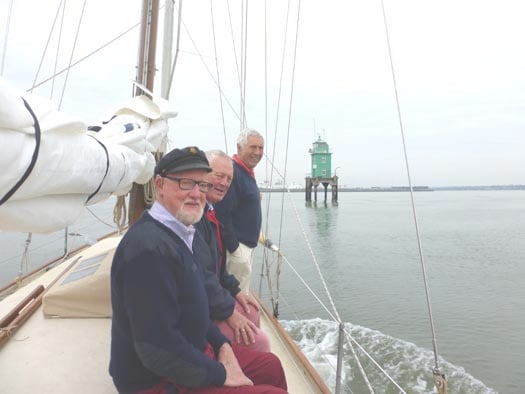
Trying to look appropriately reverential. Ed Wheeler, Brian Law and Dickie Gomes approaching Dublin Port's North Bank Lighthouse on which John B Kearney pioneered the use of screw piles. Photo: W M Nixon

"We're only here for the breakfast". Katy O'Connor's excellent catering in Poolbeg Y & BC is deservedly popular among visiting crews. Photo: W M Nixon
While we wanted to be well on time for the pre-race briefing, the main reason for getting promptly to Poolbeg was to take full advantage of Katy O'Connor's legendary breakfast at the club, and we put away enough calories to keep us going all day. At the briefing, John Alvey told us the committee were concerned that the very varied fleet – everything from Ainmara to the big Naomh Cronan, a superb Clondalkin-built re-creation of a Galway Hooker – included some boats which, in the light airs expected, could be out on the bay until nightfall.
So the plan was for a short race taking in several marks so that it could be finished at the end of any leg. But by the time we got down to Dublin Bay, it was crisp blue with a smart little sea breeze filling in to give sailing conditions which suited Ainmara to perfection, yet some of the heavier gaffers were still lumbering slowly about in what to them was a light wind.
They may have been lumbering about, but several were very determined to make a sharp start right on the committee boat. Anyone accustomed to quick-turning and fast-accelerating modern boats will find a fleet of traditional and classic gaffers a real education. They take time to get moving, they take for ever to stop, you point them a long way out, and their bowsprits – "dock probes" as marina managers call them – seem intent on skewering everyone else.
But while our skipper may pretend to be just an old cruising man these days, his racing blood was up. We set ourselves to sweep into what we hoped would be a gap starting to appear at the committee boat seconds after the start signal. We consoled ourselves with the thought that in extremis, we might just manage to shoot head to wind leaving the committee boat to port, ruining our start perhaps, but preserving the Ainmara intact.
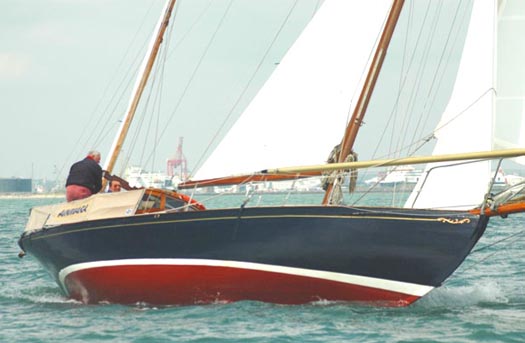
"Go for it, and let's hope there's a gap when we get there..." Ainmara starts to build speed towards her start in the Leinster Trophy Race 2014 . Photo: Gill Mills
So she was set at it, despite attempts to slow her a bit the speed built up, but as quickly as I'm telling this the gap started to appear and she zapped into it and just managed to keep her wind clear on Sean Walsh's remarkably fast Heard 28 Tir na nOg and Denis Aylmer's Mona. Now we had to find the DBSC marks in the right sequence, but Ed was on top of it feeding co-ordinates and giving out courses, we found that with a bit of luck we might just lay the first mark close hauled, and though Tir na nOg – whose waterline length is much the same as Ainmara's – hung in very well, he'd to tack for the mark while we scraped by it, so after that it was up jib tops'l and making hay.
But though we took line honours, we felt certain Tir na nOg would win on corrected time, as a Heard 28 sailed as well as she is can be one very potent performer, and Sean seemd to be still right on our stern at the finish. The results wouldn't be announced until Monday evening, so that Saturday afternoon we wandered back upriver to Poolbeg in sunshine so powerful that an afternoon zizz was your only man, and then we emerged on deck to find that others were arriving in port, with one of the the Welsh visitors, the engine-less Happy Quest from Milford Haven, making a copy-book job of berthing under sail, and then all was alive with the Howth Seventeens arriving in from their home port after a very close-fought passage race which had been narrowly won by Conor Turvey sailing Isobel.

Happy Quest from southwest Wales lives up to her name with a successful berthing under sail only at Poolbeg. Photo: W M Nixon
The Seventeens were there to put on a display race next day (Sunday) in the Liffey as part of the three day Dublin Port Riverfest over the Bank Holiday weekend. Inevitably for those of us who took part in the first one in 2013 when the OGA Golden Jubilee was top of the bill, there wasn't quite the same buzz, but first-timers watching aboard the restaurant ship Cill Airne assured us they found it very exciting indeed, and were especially impressed by the waterborne ballet of the two big harbour tugs Shackleton and Beaufort, while the funfairs and entertainment shows along the quays really did provide something for everything.
Once again the very sight of the Seventeens – which we in Howth tend to take for granted – was fascinating in the city setting. Though the promise of a decent breeze evaporated, Race Officer Harry Gallagher managed to get enough in the way of results to declare Peter Courtney with Oonagh the winner, an appropriate result for an historic class making a show performance, as the Courtneys have been involved with the Howth Seventeens since 1907.
I watched it all from an appropriate setting, aboard the Dutch Tall Ship Morgenster, a handsome 150ft brig which should be required visiting for anyone promoting the idea of a new Tall Ship for Ireland. For the Morgenster – which was re-configured as a sailing ship in 2009 – is run as a commercial venture, and can pay her way through being the right size to be a business proposition, helped by being based in the Netherlands. Thus she has a vast continental catchment area nearby to attract trainees of all ages and abilities who are prepared to pay enough for berths to keep the show efficiently on the road. There are several Dutch-based tall ships run in the same way, and the message is that if you're going to make a go of it commercially, you have to have a large enough and readily-accessed market to make it viable, and you need a boat big enough to carry sufficient trainees relative to the size of the ship – 36 in Morgenster's case – to balance the books.
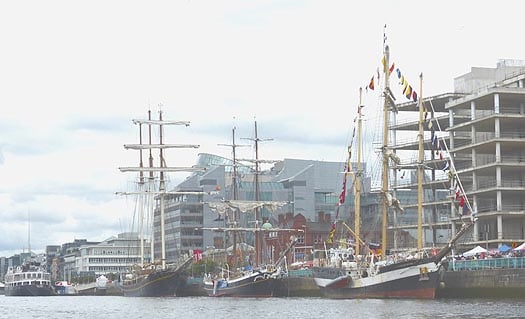
Tall ships in the Liffey, with the commercially-run 150ft sail training big Morgenster at centre. Photo: W M Nixon
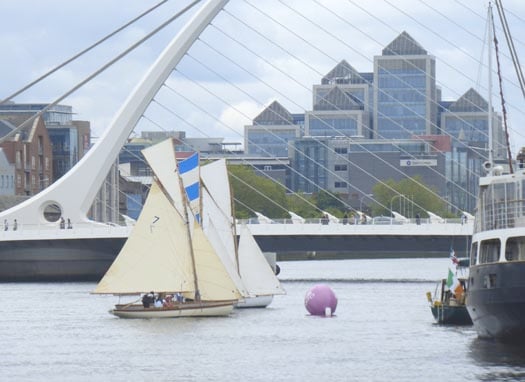
Sails and the city – Howth 17s at the Sam Beckett bridge Photo: W M Nixon
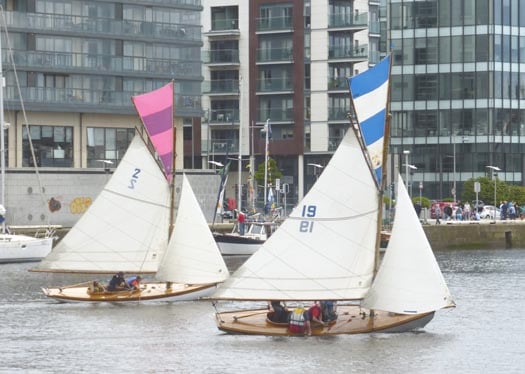
There was just enough wind for the first race for the Howth 17s to show what they could do in the Liffey if the breeze held up. Photo: W M Nixon
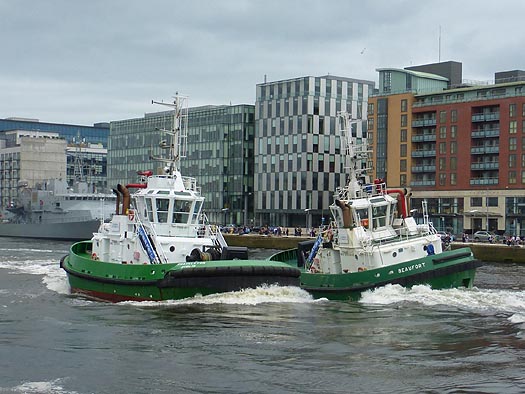
The Dublin Port tugs have awesome power to deploy in their waterborne "ballet" Photo: W M Nixon
But enough of solemnity. We went downriver again for farewells at Poolbeg, and then away across Dublin Bay and round the Baily for a seafood feast in Howth at the new place Crabby Jo's, and a handy overnight stop before using a good westerly next morning to give us a push towards Ardglass where we needs must stop, as the tides into Strangford Lough are a door slammed shut every six hours. But as ever, Ardglass's convenient and friendly little marina provided the perfect decompression chamber, and up in Mulherron's the crack was mighty with the crew of the famous restored Manx longliner Master Frank, just the two of them with skipper Joe Pennington - aka The Rat – being crewed by a psychiatrist who claimed to be strictly on holiday, but we did wonder, as any gathering of Old Gaffers is better than a wardful of nutters.
Ainmara's mini-voyage concluded next day with a text message from Dublin to tell us we'd retained the Leinster Trophy, which surprised us, and then with an idyllic sail in a sunny sou'wester, everything set to the jib tops'l, and all sail carried right through The Narrows, across Strangford Lough and thorough Ringhaddy Sound, and on across a blue sea among green islands past tree covered shores until we handed the sails just off the entrance to Down Cruising Club's isle-girt outer anchorage immediately south of Mahee Island, in a little sheltered area which has somehow acquired the unlovely name of Pongo Bay.

Home again. Ainmara back on her mooring in Strangford Lough, with Brian Law's classic yawl Twilight astern. Photo: W M Nixon
There, Ainmara is securely moored close to Brian Law's own cruising boat, the beautifully restored classic Lion Class yawl Twilight, designed by Arthur Robb. Like Dickie Gomes, Brian does all his own boatwork in a hayshed beside the house. So closely intertwined are their interests that they readily crew for each other, and of course the exchange of information and assistance and re-fit ideas is continuous.
And there's one further fact about these guys which may be of interest to other cruising crews. Aboard Ainmara during the three seasons in which I've cruised on her since she was restored for her Centenary in 1912, there's no kitty to cover expenses. There's an underlying feeling that as the skipper provides the boat, the crew owe him on a permanent basis. Thus if we get into a port and there's a choice between a comfortable marina berth or hanging off a quay wall, the crew will simply slip away and discreetly pay for a marina berth, and then tell the skipper it's a done deal.
Equally, when ashore for a meal, one of the crew will usually sidle off and pay for everyone when no-one else is looking. But if the skipper thinks the day has gone particularly well, you'll sometimes find he's paid for it all himself, As for getting diesel, whoever is carrying the cans will pay for it himself. Then too, when stores are required, it's covered by whoever goes to get them. It all sounds like an accountant's nightmare, yet so far, somehow at the end of the cruise everyone is content with the feeling that it has all balanced out, and as it has worked well for three years and longer, the attitude is that if it ain't broke, then don't try and fix it.
It had been hoped that Ainmara could stay on in the Dublin area for a week to do the Howth YC's Lambay Race in the Old Gaffers division on June 7th, as she won it in 1921. However, there was too much work still to be done to get her completely ready for a busy cruise programme coming rapidly down the line. But as she'll have to be back next year to defend the Leinster Trophy again, who knows but the double event might be done in 2015. As it was, her need for further fitting-out nearer to home was the saving of me, as a mighy temptation arose. The ancient Madcap from the north had stayed on in Dublin Bay, and was doing the Lambay Race with other old gaffers. The word on the waterfront is that Madcap may well be sold to France to be the centrepiece of a maritime museum in La Rochelle. So the Lambay Race might well be the last chance to sail on a 140-year-old boat. A place was secured on board.

The gaffers gather......Tir na nOg, Madcap and Naomh Cronan on misty morning in Howth before the Lambay Race. Photo: W M Nixon
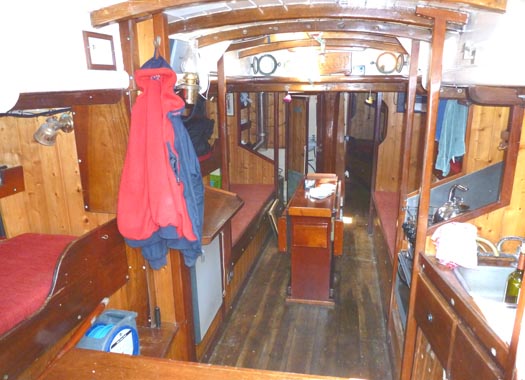
Madcap's sensible accommodation (above and below) reflects the seagoing needs of the pilots for whom she was built140 years ago. Photo: W M Nixon
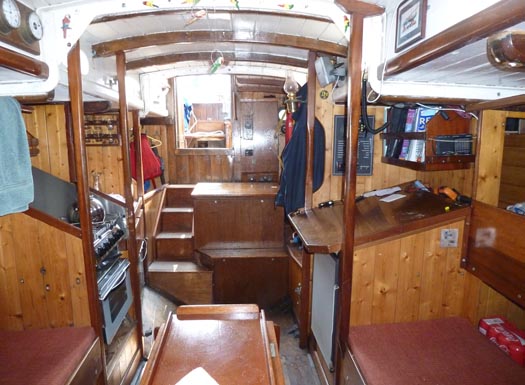
Madcap's owner for more than twenty years now has been Adrian "Stu" Spence, a rugged Belfast barrister who has the essential determination to keep such an ancient boat going. And going places too – he has been to Greenland and several times to Spain and Brittany, and has brought his old cutter through many a problem to log an impressive voyaging record.
If you have a boat of this age, your motto is: When God made time, he made a lot of it. Thus although the Old Gaffer's division was due to start at 1135, five minutes after the Howth Seventeens had set off through Howth Sound to sail the traditional Lambay course leaving Ireland's Eye to starboard and Lambay to port in order to celebrate the centenary of the Lynch family's Howth 17 Echo, it was pushing 1140 by the time we mde our leisurely debut to follow other other gaffers, which had Sean Walsh's keenly-sailed Tir na nOg soon disappearing into the misty asterly, followed by the Galway hooker Naomh Cronan helmed by the great Paddy Murphy of Renvyle, the Cornish crabber Alice (Mark Lynch) and then Madcp in her own good time.
With Northern Ireland Old Gaffers Association President Peter Chambers on the helm, Madcap settled gently into her stride, showing that she needs very little steering – she'll maintain a straight line for miles without the wheel being touched or secured in a any way. It's an oddly soothing characteristic, just the thing to calm a man down after a hectic week in the High Court, and she soon was making her own best speed with a bit of bite now in the breeze, putting Alice astern and keeping Naomh Cronan handily in touch.

"Is it always this foggy off Howth?" Stu Spence and Peter Chambers with he visibility closing in during the Lambay Race. Photo: W M Nixon
The mist became fog, but as ever it was difficult to tell just how thick it was until we suddenly found ourselves surrounded by wraiths in the gloom. It was Class 0 racing towards Lambay, and overtaking us just feet away, giving dramatic close-ups of some of the most likeable boats on the East Coast, with Stephen O'Flaherty's Spirit 54 Soufriere pacing it with Chris Hourican's First 47.7 Pretty Polly and the Tyrrell family from Arklow with their handsome J/122 Aquelina.
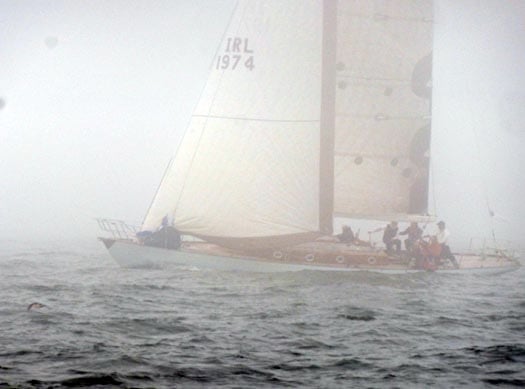
Do not adjust your sets, it really was this foggy for a while. Stephen O'Flaherty's Spirit 54 Soufriere in the fog during the Lambay Race Photo: W M Nixon

Chris Hourican's First 47.7 Pretty Polly in close-up Photo: W M Nixon
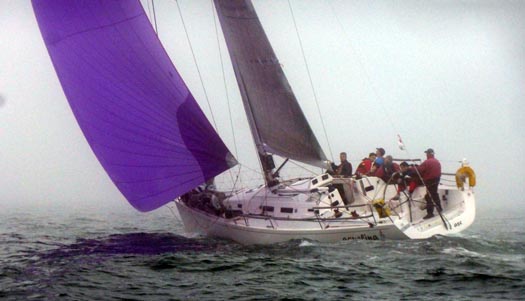
The Tyrrell family's J/122 Aquelina looking her best as she slices through the fog. Photo: W M Nixon
The fog was lifting as we got to the island with boats everywhere – the gaffermen were most impressed. Naomh Croanan had been overtaken, and Peter found us the perfect track along the flukey north side of Lambay, with Madcap effortlessly sliding over the smooth sea on a dead run and apparently consolidating her position.
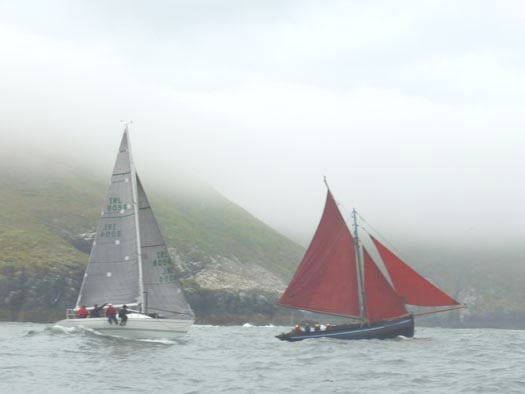
The fog start to lift. Dave Cullen's Half Tonner King One and te Naomh Cronan pproaching the east point of Lambay. Photo: W M Nixon
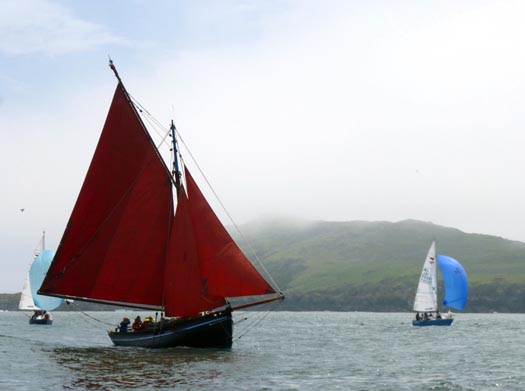
It could be Connemara...., .Naomh Cronan and two Puppeteer 22s off the north coast of Lambay Photo: W M Nixon

The long haul to the finish, the sun is out, and the breeze is beginning to develop enough power to suit Madcap. Photo: W M Nixon
But that was only until we started to head south back to the finish in Howth Sound. The Bermudan boats could lay it, so could the Seventeens, but poor old Madcap was even outpointed by Naomh Cronan, which Paddy Murphy very skilfully kept inside the line of foul tide in Lambay Sound and began to nibble at our lead, while we sagged to lee.
The sun was out, the sailing was lovely, we were surrounded by bustling classes of Puppeteer 22s and Ruffians 23s, and I suggested that a bit more tension in the jib luff, might do the trick, only to be told that as the bowsprit was no more than a liberated telegraph pole, it wasn't really up to the loads which would be put on it by trying to maximise the performance of a 22-ton boat, and nobody wanted splinters flying every which way aboard a boat where the mainboom looked to weigh at least half a ton.
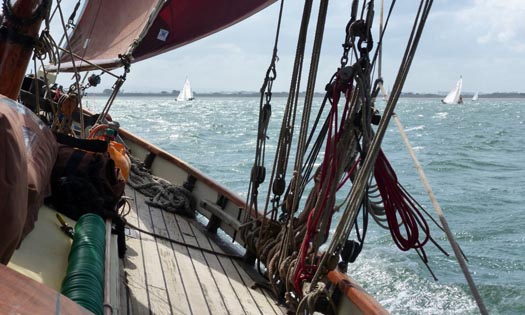
A bite to the breeze, with little boats everywhere – and all of them on starboard. Photo: W M Nixon

The Dun Laoghaire Ruffian 23s made a weekend of it for the Lambay Race, coming over on the Friday night, partying mightily, and then going out to race on Saturday in a rising breeze. Photo: W M Nixon
As it is the loads becme quite something as the breeze freshened sunny and squally down the north flank of the hjill of Howth. By the time we made it across the line, Madcap was going well on smooth water under just mainsail and staysail. But though Naomh Cronan was still ahead and rightly delighted with themselves at getting a good second, it was Tir na nOg which had been in race of her own. Yet as Sean Walsh reported with astonishment, he hadn't been able to get among the slippy little Howth 17s, where John Curley and Marcus Lynch had a good win with Rita, Howth Seventeen No. 1.
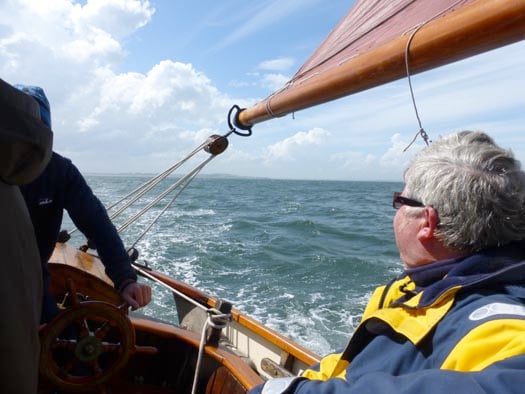
Finally there was enough breeze for Madcap's wake to stretch satisfyingly astern while she could point better with the jib brought in, but Naomh Cronan still finished ahead to take second prize. Photo: W M Nixon

The mighty helmsman of Renvyle. Paddy Murphy (left) steered Naomh Cronan to an excellent performance in the Lambay Race 2014. With him is DBOGA Hon Sec Gerry Murtagh with a trophy he won racing round Lambay in 1986. Photo: W M Nixon
It seemed an Old Gaffers Classic Lambay Race had been inaugurated, and Sean Walsh, international President of the OGA, was most appropriately the first winner. It was something to celebrate, and it duly was, in the sunshine at Howth YC. But in time, I had to take myself away and go for a long walk with the little dog along the beach. For when you've been sailing on a 140-year-old boat, there's a need to ponder the passing years, and this crazy sport of ours in which museum pieces are part of the action.
Unique Riverfest Liffey Race Gets Results for Howth 17s
A windless day played havoc for the Howth 17s fleet which battled to complete a course but they managed to complete two good races, the first race of their kind in Dublin writes Gillian Mills.
It is said that time and tide waits for no man, and neither can a working port whose lifting bridge determined when these classic craft and others in the Dublin Port Riverfest/OGA 50 had to exit to clear water.
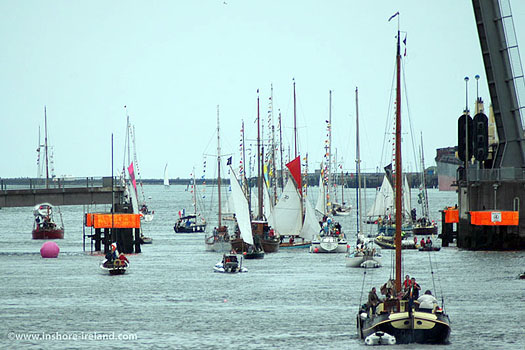
The Howth 17s – widely regarded as the world's oldest one-design keelboat class still racing as originally designed – will play centre stage of a three-day sailing regatta in Dublin Bay on June 1.
Adding backdrop splendour along the city quays will be five Class A&B Tall Ships, as part of the OGA50th/ Dublin Port River Festival which will see classic craft competing for the inaugural RMS Leinster Trophy and Asgard Trophy, and the Howth 17s competing in the River Liffey Race between the East Link and Samuel Beckett Bridges.
SATURDAY JUNE 1
Leinster Trophy
TIME: 11am*
Inaugural race following the course towards the final resting place of the Royal Mailboat RMS Leinster which was torpeoded and sunk on October 10, 1918, while on passage from Kingstown (Dún Laoghaire) to Holyhead, just five miles east of the Kish Lighthouse in Dublin Bay.
Howth 17s - Howth to Dublin feeder race
SUNDAY JUNE 2
Liffey Race and Parade of Sail
1pm: Liffey Race
(East Link-Sam Beckett)
3pm: POS
The Howth 17s were designed in 1897 by Howth lawyer and founding Commodore of Howth YC, Herbert Boyd. The first five boats were built by John Hilditch, Carrickfergus.
Two years later another three boats were built in Dún Laoghaire and five more in Portrush in 1906. During the next six years, four more boats were built, bringing the fleet to 17.
MONDAY JUNE 3
Asgard Trophy
TIME: 1pm*
Participants in this unique race in Dublin Bay will be competing for the trophy crafted from original and new timbers used in the construction and restoration of the famous Howth gun-runner, Asgard.
The splendidly restored vessel is now on view in Collins Barracks, National Museum of Ireland.
Howth Yacht Club Lays Out 2011 Sailing Programme
At a launch reception in the club on Thursday 31st March attended by representatives of local commerce, tourism and community bodies, HYC Commodore Roger Cagney announced that in addition to junior and adult sail training courses and club racing four days a week in the summer months, the Club would host over 20 open events during the year.
"We are used to sailing being a year-round activity," he said, "but even by our standards this will be an exceptionally busy year for Howth Yacht Club. We are fortunate in the number of talented volunteers we can call upon to help make these events successful and we have an enviable track record in this regard. We are also extremely grateful for the sponsorship of individual events from commercial concerns, details of which will be released in due course."
The major event on the 2011 calendar is undoubtedly the European Championship of the J24 Class, the world's most popular racing keelboat, when over 200 sailors from six or more countries will compete in the four-day regatta in September.
Howth will also host the Irish Championships of four classes – Puppeteer, Squib, Howth 17 and Optimist – between July 1st and late-August, with the latter attracting up to 200 competitors, together with their families, coaches and supporters. In addition, HYC will run the SB3 Eastern Championships (end April), the RS Feva Leinsters (late May) and the Dublin Match Racing Open (in J80s in early September).
The club's programme also comprises the Spring Warmer series in April, the annual Lambay Races on June 11th, the Dinghy Regatta a week later and the ever-popular Autumn League over five weekends in September/October.
Unique footage of 1926 Dun Laoghaire Regatta Uncovered
Here's a unique glimpse of a post World War One Dun Laoghaire Regatta in rare newsreel recently archived by British Pathe (below). The shots taken on August 2nd 1926 show a mixture of long shots of yachts sailing across Dublin bay. There's definitely lovely shots of Dublin Bay 21s enjoying a tight race, a brave gybe by a Dublin Bay 25 at the harbour mouth plus shots of some Howth 17s.
There's panning shots of in harbour rowing races and high angled shots of men diving off the side of a boat and into the harbour. The swimmers race the length of an area cordoned off by rowing boats with spectators watching from the boats. There is also a shot of women's swimming race and some diving too.
We'd like your observations on these shots, particularly any details of the large committee boat dresssed overall. Leave your comments below. Enjoy.
Scroll down for the clip.
A Century of Sailing: Documentary Launch
A little fleet of boats based in Howth has sailed through three centuries to become the oldest one-design yachts in the world still racing. How did they do it? The answer is an "extraordinary love story" of passion, pride and dedication that is chronicled in "A Century of Sailing". This half-hour documentary follows the 112-year-old Howth 17 fleet through a season of challenges, including the revival of 100-year-old boat-building skills to expand the fleet for the first time in nearly a century. Filmed in high definition against a beautiful scenic backdrop, a DVD of this documentary will be launched with a special screening in Howth Yacht Club next Saturday.
Time: 4pm, Saturday, December 18
Location: Howth Yacht Club, Howth, Co. Dublin


























